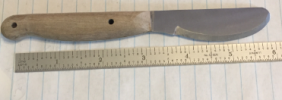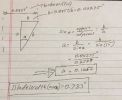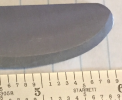Are you mixing up the edge angle with the bevel angle. The bevel is rarely more than 10° on any kitchen knife. A camp knife in 1/4" steel would only have a 15° inclusive angle with a 1" high shinogi. A camp knife in .25" steel with a 2" blade and a FFG has a 9.5° bevel angle.
The edge angle is put on after the main bevel to the shinogi is added.
A photo would help, also blade thickness, width, and shinogi height desired.
Ok Stacy - here you go. I am not mixing up the edge angle and the bevel angle (also am not confusing the single-sided angle with the full two-sided angle). The concept here is this: my wife discovered that she likes using some of our old, cheap, tinny, overly light,, butter knives as a "dinner knife".

Her hands are small, so the small handle works well for her, and the blades on our regular dinner knives really are quite long and unwieldy. I thought I would make something for her that is more hefty, sharper, easier to hold ... so we sketched out something that was better contoured for her hand, but yet retains the basic blade shape/geometry of the cheap originals. She was also quite clear that she liked the rounded blade tip, AND liked to use that extreme curve on the tip as part of the cutting edge. So ... this is what we came up with:

(this, and its 3 partners, are still a work in progress - need to finalize the blade finish, and finish-sand, pin, and oil the handle - also, in a lot of ways, these blades are part of a couple "learning" projects - so there are imperfections I am well aware of :-( ). My target was to not make this blindingly sharp, but rather with an edge robust enough for daily usage against ceramic plates (dont scream - these are dinner knives after all..

). Hence I am targeting 15 degree secondary bevels, and an edge angle of 25 degrees.
Here are the calculations (and blade dimensions) to determine the Shinogi location given that 15 degree bevel:

Not sure if you want to wade through the calcs, but I have double checked them, and the final shinogi location (my dimension "a") of 0.16" from the edge is what was achieved on the ground blades. (given the relative thicknesses of this blade versus your "camp knife" example, I think this is pretty consistent with your example)
So ... here is the issue: going back to the photo of the actual blade, but zooming up on the tip:

I would have "liked" (for looks) for the bevel to go further up the blade (1/3 - 1/2 of the way), but with the significant curvature of the blade relative to thickness, where on the blade would I make that determination of shinogi versus blade width? Also, a shallower (lower angle) bevel presented two concerns: it might not be robust against daily usage against said nasty ceramic plates, AND trying to continue that shallow bevel (& shinogi) a significant way around the rounded tip would have resulted in a really weird looking tip - and even maybe the possibility of the shinogi "doubling back" on itself while going around the curved tip (also would be really challenging, at least for me, to actually do that...). Given all that ... my only real answer was to settle for the 15 degree bevel and just go with it (based on performance and execution needs).
BUT, that gave rise to this bevel that is ground to (or close to) the criteria I targeted, but is nevertheless rather funky looking (I DOES look alot like a "smiley face"....... ). Hence my original question: do you typically decide on shinogi location based only on "looks" in terms of the overall knife ... or do you decide on what angle you want on the bevel to be based on function and go with that? IN this case, using the latter gave rise to something a little more funky than I wanted (but still functional). The only other thing I can think of is to have tried to define the shinogi that looked good, then try to execute a grind that gave a variable bevel angle depending on where you are on the blade, in order to achieve the pre-defined shinogi location.
How would you have dealt with the conflicts here and proceeded on this???
(btw - this is not an idle question: my intent was/is always to make a final set out of stainless damascus, and use these as a learning process. Also, one of the "mates" of this knife has a brass bolster - and we both agree that the bolster gives a much better "look and feel" to the knife - so the final versions (if/when I get around to them) will all have bolsters.....)





